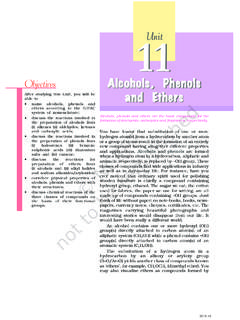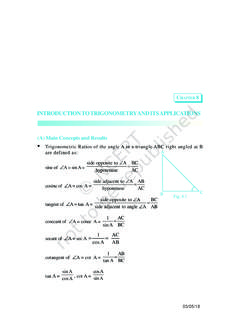Transcription of Surface Chemistry - NCERT
1 Surface Chemistry deals with phenomena that occurat the surfaces or interfaces. The interface or surfaceis represented by separating the bulk phases by ahyphen or a slash. For example, the interface betweena solid and a gas may be represented by solid-gasor solid/gas. Due to complete miscibility, there is nointerface between the gases. The bulk phases thatwe come across in Surface Chemistry may be purecompounds or solutions. The interface is normally afew molecules thick but its area depends on the sizeof the particles of bulk phases. Many importantphenomena, noticeable amongst these beingcorrosion, electrode processes, heterogeneouscatalysis, dissolution and crystallisation occur atinterfaces. The subject of Surface Chemistry findsmany applications in industry, analytical work anddaily life accomplish Surface studies meticulously, itbecomes imperative to have a really clean very high vacuum of the order of 10 8 to 10 9pascal, it is now possible to obtain ultra clean surfaceof the metals.
2 Solid materials with such cleansurfaces need to be stored in vacuum otherwise thesewill be covered by molecules of the major componentsof air namely dioxygen and this Unit, you will be studying some importantfeatures of Surface Chemistry such as adsorption,catalysis and colloids including emulsions and Chemistry5 Surface ChemistryAfter studying this Unit, you will beable to describe interfacial phenomenonand its significance; define adsorption and classify itinto physical and chemicaladsorption; explain mechanism of adsorption; explain the factors controllingadsorption from gases andsolutions on solids; explain adsorption results on thebasis of Freundlich adsorptionisotherms; appreciate the role of catalysts inindustry; enumerate the nature of colloidalstate; describe preparation, propertiesand purification of colloids; classify emulsions and describetheir preparation and properties; describe the phenomenon of gelformation; list the uses of of the most important chemicals are produced industrially bymeans of reactions that occur on the surfaces of solid are several examples, which reveal that the Surface of a solid has thetendency to attract and retain the molecules of the phase with which itcomes into contact.
3 These molecules remain only at the Surface and donot go deeper into the bulk. The accumulation of molecular speciesat the Surface rather than in the bulk of a solid or liquid is termedadsorption. The molecular species or substance, which concentrates oraccumulates at the Surface is termed adsorbate and the material on thesurface of which the adsorption takes place is called is essentially a Surface phenomenon. Solids, particularlyin finely divided state, have large Surface area and therefore, charcoal,silica gel, alumina gel, clay, colloids, metals in finely divided state, as good in action(i)If a gas like O2, H2, CO, Cl2, NH3 or SO2 is taken in a closed vesselcontaining powdered charcoal, it is observed that the pressure of thegas in the enclosed vessel decreases. The gas molecules concentrateat the Surface of the charcoal, , gases are adsorbed at the Surface .(ii)In a solution of an organic dye, say methylene blue, when animalcharcoal is added and the solution is well shaken, it is observedthat the filtrate turns colourless.
4 The molecules of the dye, thus,accumulate on the Surface of charcoal, , are adsorbed.(iii)Aqueous solution of raw sugar, when passed over beds of animalcharcoal, becomes colourless as the colouring substances areadsorbed by the charcoal.(iv)The air becomes dry in the presence of silica gel because the watermolecules get adsorbed on the Surface of the is clear from the above examples that solid surfaces can holdthe gas or liquid molecules by virtue of adsorption. The process ofremoving an adsorbed substance from a Surface on which it isadsorbed is called adsorption, the substance is concentrated only at the Surface anddoes not penetrate through the Surface to the bulk of the adsorbent,while in absorption, the substance is uniformly distributed throughoutthe bulk of the solid. For example, when a chalk stick is dipped in ink,the Surface retains the colour of the ink due to adsorption of colouredmolecules while the solvent of the ink goes deeper into the stick dueto absorption.
5 On breaking the chalk stick, it is found to be white frominside. A distinction can be made between absorption and adsorptionby taking an example of water vapour. Water vapours are absorbed byanhydrous calcium chloride but adsorbed by silica gel. In other words,in adsorption the concentration of the adsorbate increases only at thesurface of the adsorbent, while in absorption the concentration isuniform throughout the bulk of the adsorption and absorption can take place simultaneouslyalso. The term sorption is used to describe both the arises due to the fact that the Surface particles of the adsorbentare not in the same environment as the particles inside the bulk. Insidethe adsorbent all the forces acting between the particles are Chemistrybalanced but on the Surface the particles are not surrounded by atomsor molecules of their kind on all sides, and hence they possess unbalancedor residual attractive forces.
6 These forces of the adsorbent are responsiblefor attracting the adsorbate particles on its extent ofadsorption increases with the increase of Surface area per unit mass ofthe adsorbent at a given temperature and important factor featuring adsorption is the heat ofadsorption. During adsorption, there is always a decrease in residualforces of the Surface , , there is decrease in Surface energy whichappears as heat. Adsorption, therefore, is invariably an exothermicprocess. In other words, H of adsorption is always negative. When agas is adsorbed, the freedom of movement of its molecules becomerestricted. This amounts to decrease in the entropy of the gas afteradsorption, , S is negative. Adsorption is thus accompanied bydecrease in enthalpy as well as decrease in entropy of the system. Fora process to be spontaneous, the thermodynamic requirement is that,at constant temperature and pressure, G must be negative, , thereis a decrease in Gibbs energy.
7 On the basis of equation, G = H T S, G can be negative if H has sufficiently high negative value as T Sis positive. Thus, in an adsorption process, which is spontaneous, acombination of these two factors makes G negative. As the adsorptionproceeds, H becomes less and less negative ultimately H becomesequal to T S and G becomes zero. At this state equilibrium is are mainly two types of adsorption of gases on accumulation of gas on the Surface of a solid occurs on account ofweak van der Waals forces, the adsorption is termed as physicaladsorption or physisorption. When the gas molecules or atoms areheld to the solid Surface by chemical bonds, the adsorption is termedchemical adsorption or chemisorption. The chemical bonds may becovalent or ionic in nature. Chemisorption involves a high energy ofactivation and is, therefore, often referred to as activated these two processes occur simultaneously and it is noteasy to ascertain the type of adsorption.
8 A physical adsorption at lowtemperature may pass into chemisorption as the temperature isincreased. For example, dihydrogen is first adsorbed on nickel by vander Waals forces. Molecules of hydrogen then dissociate to form hydrogenatoms which are held on the Surface by of the important characteristics of both types of adsorptionare described below:Characteristics of physisorption(i)Lack of specificity: A given Surface of an adsorbent does not show anypreference for a particular gas as the van der Waals forces are universal.(ii)Nature of adsorbate: The amount of gas adsorbed by a soliddepends on the nature of gas. In general, easily liquefiable gases( , with higher critical temperatures) are readily adsorbed as vander Waals forces are stronger near the critical temperatures. Thus,1g of activated charcoal adsorbs more sulphur dioxide (criticaltemperature 630K), than methane (critical temperature 190K) whichis still more than mL of dihydrogen (critical temperature 33K).
9 OfAdsorption2022-23126 Chemistry (iii)Reversible nature: Physical adsorption of a gas by a solid isgenerally reversible. Thus,Solid + Gas l Gas/Solid + HeatMore of gas is adsorbed when pressure is increased as thevolume of the gas decreases (Le Chateliers s principle) and thegas can be removed by decreasing pressure. Since the adsorptionprocess is exothermic, the physical adsorption occurs readily atlow temperature and decreases with increasing temperature(Le-Chatelier s principle).(iv) Surface area of adsorbent: The extent of adsorption increaseswith the increase of Surface area of the adsorbent. Thus, finelydivided metals and porous substances having large Surface areasare good adsorbents.(v)Enthalpy of adsorption: No doubt, physical adsorption is anexothermic process but its enthalpy of adsorption is quite low (20 40 kJ mol-1). This is because the attraction between gas moleculesand solid Surface is only due to weak van der Waals of chemisorption(i)High specificity: Chemisorption is highly specific and it willonly occur if there is some possibility of chemical bondingbetween adsorbent and adsorbate.
10 For example, oxygen isadsorbed on metals by virtue of oxide formation and hydrogenis adsorbed by transition metals due to hydride formation.(ii)Irreversibility: As chemisorption involves compound formation, itis usually irreversible in nature. Chemisorption is also anexothermic process but the process is very slow at lowtemperatures on account of high energy of activation. Like mostchemical changes, adsorption often increases with rise oftemperature. Physisorption of a gas adsorbed at low temperaturemay change into chemisorption at a high temperature. Usuallyhigh pressure is also favourable for chemisorption.(iii) Surface area: Like physical adsorption, chemisorption alsoincreases with increase of Surface area of the adsorbent.(iv)Enthalpy of adsorption: Enthalpy of chemisorption is high(80-240 kJ mol-1) as it involves chemical bond arises because of van derWaals is not specific in is reversible in depends on the nature ofgas.













